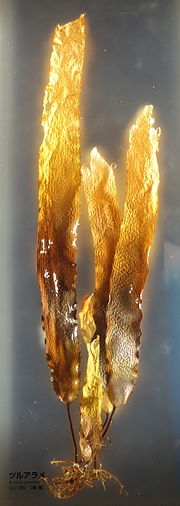| Ecklonia stolonifera | |
|---|---|

| |
| Ecklonia stolonifera | |
| Scientific classification | |
| Domain: | Eukaryota |
| Clade: | Diaphoretickes |
| Clade: | SAR |
| Clade: | Stramenopiles |
| Phylum: | Gyrista |
| Subphylum: | Ochrophytina |
| Class: | Phaeophyceae |
| Order: | Laminariales |
| Family: | Lessoniaceae |
| Genus: | Ecklonia |
| Species: | E. stolonifera
|
| Binomial name | |
| Ecklonia stolonifera Okamura, 1913
| |
Ecklonia stolonifera (Japanese: ツルアラメ, turuarame) is a brown alga species in the genus Ecklonia found in the Sea of Japan. It is an edible species traditionally eaten in Japan.[1]
Chemistry
[edit]Phlorotannins
[edit]Ecklonia stolonifera contains the phlorotannins phlorofucofuroeckol A,[2] eckol, dieckol,[3] dioxinodehydroeckol[4] (eckstolonol),[5] 2-phloroeckol, phlorofucofuroeckol B, 6,6'-bieckol,[6] triphlorethol-A,[7] phloroglucinol and 7-phloroeckol.[8]
Those phlorotannins are responsible for the potent pharmacological effects associated with this seaweed.[9] These molecules show a hepatoprotective activity.[6][10]
Oxylipins
[edit]The oxylipins ecklonialactones A, B,[11] C, D, E and F[12] and fucosterol[7] can also be isolated from the species.
References
[edit]- ^ Kuda, Takashi; Kunii, Taeko; Goto, Hideyuki; Suzuki, Takamoto; Yano, Toshihiro (2007). "Varieties of antioxidant and antibacterial properties of Ecklonia stolonifera and Ecklonia kurome products harvested and processed in the Noto peninsula, Japan". Food Chemistry. 103 (3): 900. doi:10.1016/j.foodchem.2006.09.042.
- ^ Kim, AR; Lee, MS; Shin, TS; Hua, H; Jang, BC; Choi, JS; Byun, DS; Utsuki, T; Ingram, D; Kim, HR (2011). "Phlorofucofuroeckol a inhibits the LPS-stimulated iNOS and COX-2 expressions in macrophages via inhibition of NF-κB, Akt, and p38 MAPK". Toxicology in Vitro. 25 (8): 1789–95. doi:10.1016/j.tiv.2011.09.012. PMID 21963823.
- ^ Goo, HR; Choi, JS; Na, DH (2010). "Quantitative determination of major phlorotannins in Ecklonia stolonifera". Archives of Pharmacal Research. 33 (4): 539–44. doi:10.1007/s12272-010-0407-y. PMID 20422362. S2CID 26981463.
- ^ Shim, SY; Choi, JS; Byun, DS (2009). "Inhibitory effects of phloroglucinol derivatives isolated from Ecklonia stolonifera on Fc(epsilon)RI expression". Bioorganic & Medicinal Chemistry. 17 (13): 4734–9. doi:10.1016/j.bmc.2009.04.050. PMID 19443227.
- ^ Kang, HS; Chung, HY; Jung, JH; Son, BW; Choi, JS (2003). "A new phlorotannin from the brown alga Ecklonia stolonifera". Chemical & Pharmaceutical Bulletin. 51 (8): 1012–4. doi:10.1248/cpb.51.1012. PMID 12913249.
- ^ a b Lee, Min-Sup; Shin, Taisun; Utsuki, Tadanobu; Choi, Jae-Sue; Byun, Dae-Seok; Kim, Hyeung-Rak (2012). "Isolation and Identification of Phlorotannins from Ecklonia stolonifera with Antioxidant and Hepatoprotective Properties in Tacrine-Treated HepG2 Cells". Journal of Agricultural and Food Chemistry. 60 (21): 5340–9. doi:10.1021/jf300157w. PMID 22587607.
- ^ a b Jung, Hyun Ah; Hyun, Sook Kyung; Kim, Hyeung Rak; Choi, Jae Sue (2006). "Angiotensin-converting enzyme I inhibitory activity of phlorotannins from Ecklonia stolonifera". Fisheries Science. 72 (6): 1292. doi:10.1111/j.1444-2906.2006.01288.x. S2CID 42869137.
- ^ Yoon, Na Y; Chung, Hae Y; Kim, Hyeung R; Choi, Jae S (2008). "Acetyl- and butyrylcholinesterase inhibitory activities of sterols and phlorotannins from Ecklonia stolonifera". Fisheries Science. 74: 200–207. doi:10.1111/j.1444-2906.2007.01511.x. S2CID 24337383.
- ^ Goo, Hyun Ryul; Choi, Jae Sue; Na, Dong Hee (2010). "Quantitative determination of major phlorotannins in Ecklonia stolonifera". Archives of Pharmacal Research. 33 (4): 539–44. doi:10.1007/s12272-010-0407-y. PMID 20422362. S2CID 26981463.
- ^ Kim, Youn Chul; An, Ren Bo; Yoon, Na Young; Nam, Taek Jeong; Choi, Jae Sue (2005). "Hepatoprotective constituents of the edible brown algaEcklonia stolonifera on tacrine-induced cytotoxicity in hep G2 cells". Archives of Pharmacal Research. 28 (12): 1376–80. doi:10.1007/BF02977904. PMID 16392671. S2CID 25793794.
- ^ Todd, James S.; Proteau, Philip J.; Gerwick, William H. (1994). "The Absolute Configuration of Ecklonialactones A, B, and E, Novel Oxylipins from Brown Algae of the Genera Ecklonia and Egregia". Journal of Natural Products. 57 (1): 171–4. doi:10.1021/np50103a028. PMID 8158161.
- ^ Kurata, Kazuya; Taniguchi, Kazuya; Shiraishi, Kazunari; Suzuki, Minoru (1993). "Ecklonialactones-C-F from the brown alga Ecklonia stolonifera". Phytochemistry. 33: 155–159. doi:10.1016/0031-9422(93)85413-L.
Well, that’s interesting to know that Psilotum nudum are known as whisk ferns. Psilotum nudum is the commoner species of the two. While the P. flaccidum is a rare species and is found in the tropical islands. Both the species are usually epiphytic in habit and grow upon tree ferns. These species may also be terrestrial and grow in humus or in the crevices of the rocks.
View the detailed Guide of Psilotum nudum: Detailed Study Of Psilotum Nudum (Whisk Fern), Classification, Anatomy, Reproduction